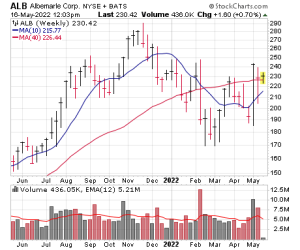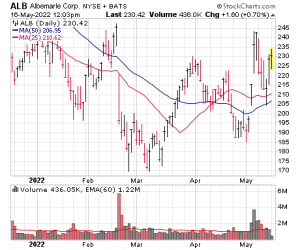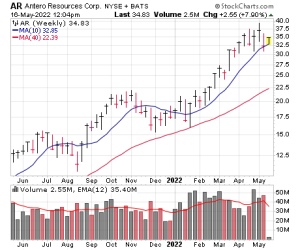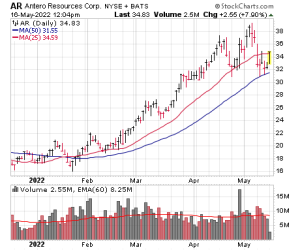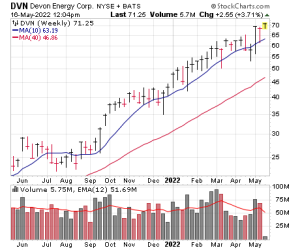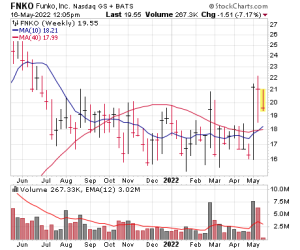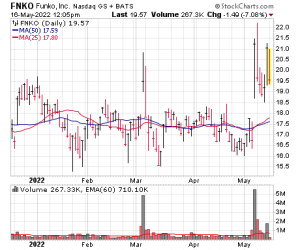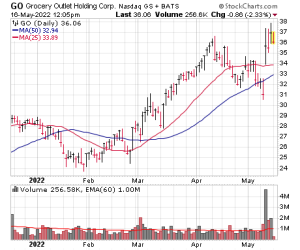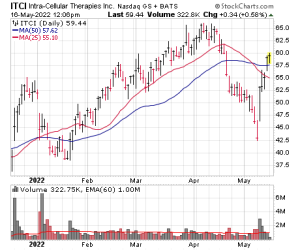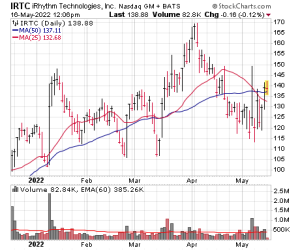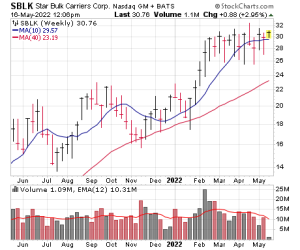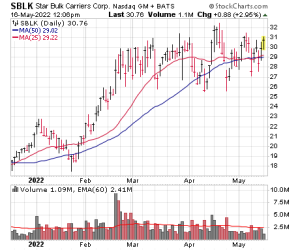Last week brought some true extremes when looking at sentiment and oversold conditions, telling us some type of bounce was likely. That’s what we saw starting Thursday afternoon, and we’re optimistic we may have hit a workable low—“workable” in this case meaning the market can work higher for more than just a couple of days. That said, we’ll just see how it goes: While there are a few stocks acting well and set up decently, the vast majority of evidence remains negative, so we still favor defense and patience as the market tries to etch a bottom.
Encouragingly, though, this week’s list does have a few names that have shown outsized support during the past couple of weeks, often after earnings, and our Top Pick is one of them as it attempts to round out its launching pad.
Cabot Top Ten Trader Issue: May 16, 2022
Possible Near-Term Low—Main Trends Still Down
Last week brought some true extremes when looking at sentiment and some oversold conditions, with so many stocks hitting new 52-week lows, so few above key moving averages and so many (especially growth) names stretched to the downside, that some type of bounce was likely. That’s what we saw starting Thursday afternoon, and we’re optimistic we may have hit a workable low—“workable” in this case meaning the market can work higher for more than just a couple of days, allowing things to get off their knees and possibly for the wheat to separate from the chaff. That said, we’ll just see how it goes: While there are a few stocks acting well and set up decently, the vast majority of evidence remains negative, so the bulls have a lot of proving to do before we change our stance—we still favor defense and patience as the market tries to etch a bottom. Our Market Monitor remains at a level 2.
Encouragingly, though, this week’s list does have a few names that have shown outsized support during the past couple of weeks, often after earnings. Our Top Pick is Albemarle (ALB), which still needs work, but may be starting to round out its launching pad as the lithium industry gains speed.
| Stock Name | Price | Buy Range | Loss Limit |
| Albemarle (ALB) ★ TOP PICK ★ | 228 | 220-230 | 197-202 |
| Antero Resources (AR) | 34 | 32.5-34 | 28-29 |
| Celsius (CELH) | 55 | 53-56 | 45-47 |
| Devon Energy (DVN) | 71 | 66-69 | 59-61 |
| Funko (FNKO) | 20 | 18.8-19.8 | 17.0-17.5 |
| Grocery Outlet (GO) | 36 | 34.5-36 | 31-32 |
| Halozyme (HALO) | 42 | 40.5-42 | 35.5-36.5 |
| Intra-Cellular Therapies (ITCI) | 59 | 54-57 | 47.5-49 |
| iRhythm Tech (IRTC) | 133 | 129-135 | 111-114 |
| StarBulk (SBLK) | 31 | 29-31 | 25-26 |
Stock 1
Albemarle (ALB) ★ Top Pick
| Price | Buy Range | Loss Limit |
| 228 | 220-230 | 197-202 |
Why the Strength
The war in Russia has accelerated the plans of developed nations to convert from fossil fuels to alternative energy that largely depend on batteries. This in turn has increased demand for battery metals like lithium, which is already benefiting from a booming electric vehicle (EV) market. Specialty chemicals maker Albemarle makes additives and intermediates for several industries, but battery-grade lithium has been the firm’s major focus in recent years and it’s now one of the world’s biggest lithium producers. Albemarle’s Q1 revenue stunned the consensus by 9% (a reason for the strength), rising an eye-popping 36% from a year ago to $1.1 billion, while per-share earnings of $2.38 exceeded estimates by 73 cents. Lithium segment sales led the way, surging 97% in the quarter, to $550 million, on higher pricing and volumes and prompting the company to forecast full-year segment EBITDA growth of over 200%. Bromine segment sales grew 28%, with EBITDA growth of up to 20% expected this year. Of greater significance, management raised guidance for full-year revenue to $5.4 billion at the midpoint (up 65% from a year ago, if realized), with earnings per share forecast at $10.70 at the midpoint (up a whopping 74% from prior guidance) based on “expectations of continued demand growth and tightness” in the lithium market. Several Wall Street firms raised their price targets for the stock in response to the blockbuster earnings, as well as on expectations of continued global lithium market scarcity. (Albemarle has restarted a mine in Australia and acquired a lithium converter in China to meet the increased demand.) Analysts see Q2 sales and EPS soaring 64% and 170%, and if management pulls the right levers, earnings should kite higher for many years.
Technical Analysis
ALB was on fire in the second half of last year, rallying from 165 to 285 between early July and late November. The November high proved to be the peak, however, and shares turned tail and spent the next 15 weeks slumping before bottoming at 170 in March (~40% correction). Shares bounced in March, etched a higher low in April and then surged on the Q1 report two weeks ago, before wobbling a bit last week. Overall ALB looks like it wants to round out its launching pad if the market cooperates; we’re OK nibbling here.
| Market Cap | $26.7B | EPS $ Annual (Dec) | |||||
| Forward P/E | 23 | FY 2020 | 4.12 | ||||
| Current P/E | 40 | FY 2021 | 4.04 | ||||
| Annual Revenue | $3.63B | FY 2022e | 10.03 | ||||
| Profit Margin | 24.8% | FY 2023e | 12.16 | ||||
| Qtrly Rev | Qtrly Rev Growth | Qtrly EPS | Qtrly EPS Growth | |
| ($M) | (vs. yr-ago-qtr) | ($) | (vs. yr-ago-qtr) | |
| Latest qtr | 1127 | 36% | 2.38 | 116% |
| One qtr ago | 894 | 2% | 1.01 | -14% |
| Two qtrs ago | 831 | 11% | 1.05 | -4% |
| Three qtrs ago | 774 | 1% | 0.89 | 3% |
Weekly Chart | Daily Chart |
Stock 2
Antero Resources (AR)
| Price | Buy Range | Loss Limit |
| 34 | 32.5-34 | 28-29 |
Why the Strength
Antero Resources has huge positions in the Marcellus and Utica shales in Ohio, Pennsylvania and West Virginia; it’s the 5th largest U.S. gas producer, the 2nd largest gas liquids producer and the top supplier to the LNG operators in the Gulf Coast (which could be big as that business ramps to meet demand for Europe). The company also owns 29% of Antero Midstream, which has a $4.8 billion market cap and pays some hefty dividends. Antero Resources is following the new playbook, with big cash flow and constrained CapEx, and management is bullish on natural gas prices—it hasn’t added any natural gas hedges in two years and has next to no hedges in place in 2023! That’s led to a what the top brass sees as a super undervalued situation: Using assumptions for $80 oil and $4.65 natural gas over the next five years, Antero believes it can crank out $10 billion of free cash flow, equal the current market cap! (Using strip prices, this year’s free cash flow alone could total $2.5 billion, or 25% of the market cap.) Of course, long-term projections of energy prices should be taken with a boulder of salt, but even if that figure proves too high by 20% or 30%, you’re talking about a rare situation and mountains of cash. And management is stepping up: The focus to this point has been on paying down debt (net debt is down to 1.1x EBITDA and headed lower), but it’s starting to ramp share buybacks, with $100 million in Q1, probably $150 million or so in Q2 and then double that or more starting in Q3, when half of all free cash flow going to buybacks … and that could still leave room for debt reduction and some solid dividends, too. We like it.
Technical Analysis
After a big recovery from a near-bust situation in 2020, AR built a good-looking base from November through February and then broke out after the Russian invasion. And the move was powerful, with shares soaring as high as 37 in mid-April before getting choppy, with a dip to 31, a push back to 39 and then the latest correction to the 50-day line (its first test of that line since the breakout). We do think AR could consolidate further, but we’re not opposed to a small purchase on dips with a loose stop.
| Market Cap | $10.1B | EPS $ Annual (Dec) | |||||
| Forward P/E | 6 | FY 2020 | -0.47 | ||||
| Current P/E | 17 | FY 2021 | 1.44 | ||||
| Annual Revenue | $4.30B | FY 2022e | 5.58 | ||||
| Profit Margin | 6.6% | FY 2023e | 6.27 | ||||
| Qtrly Rev | Qtrly Rev Growth | Qtrly EPS | Qtrly EPS Growth | |
| ($M) | (vs. yr-ago-qtr) | ($) | (vs. yr-ago-qtr) | |
| Latest qtr | 787 | -35% | 1.15 | 85% |
| One qtr ago | 2394 | 83% | 0.46 | N/A |
| Two qtrs ago | 534 | 40% | 0.19 | 280% |
| Three qtrs ago | 489 | 1% | 0.13 | N/A |
Weekly Chart | Daily Chart |
Stock 3
Celsius Holdings (CELH)
| Price | Buy Range | Loss Limit |
| 55 | 53-56 | 45-47 |
Why the Strength
Celsius looks like the next big winner in the energy drink sector, and the attraction here is that the company’s energy drink actually is aimed for active people—the drink has no preservatives, aspartame, high fructose corn syrup, or added sugar, and it’s also non-gmo. But more impressive are a few different neutral studies that show Celsius’ drinks can boost metabolism and burn body fat with no adverse health effects; the firm says its proprietary formula (which includes some green tea, ginger and guarana seed) “turns on” thermogenesis (causing the burning of calories to generate heat within the body). It seems a bit out there (more on that in a sec), but the studies look legit and, whether those benefits are big or small, there’s no question the company’s offerings (including sparkling, non-sparkling or just powder to be mixed with water, all in a variety of flavors) are steadily catching on—the firm has just over 4% market share in the industry (now the fourth-biggest brand), more than double the level from a year ago, and in the latest four-week dataset (ending mid-April), the firm accounted for 38% of the entire industry’s growth! A big part of that, of course, is distribution, and management is making big inroads there, with a nationwide launch in Sam’s Club’s starting in March and Circle K soon after; an expansion in the number of Walmarts it sells in (up to 4,400 locations); and there are inroads into fitness areas, too (launched at Lifetime Fitness in Q4). The numbers in the table below are huge, and analysts see both sales and earnings ramping from here—long term, the upside potential is huge. One yellow flag is a class action lawsuit that was launched late last year, as well as a subpoena from the SEC, though it appears to be about a China operation the firm closed a few years back; even so, news on that did hit the stock back in November. We bring that up as an FYI, but there’s no doubt the firm is doing great and many big investors (394 own shares) are willing owners.
Technical Analysis
CELH had a gigantic, gigantic run into November of last year, when the market and the SEC news quickly dragged it down from 110 to 40 (round numbers) by January. Interestingly, though, that was the low—the two retests of that area both found big buying, including last week’s move after earnings, which brought the heaviest weekly volume since last June. There is resistance right above here, but if you want in we’re not opposed to a nibble here.
| Market Cap | $4.36B | EPS $ Annual (Dec) | |||||
| Forward P/E | 130 | FY 2020 | 0.11 | ||||
| Current P/E | 385 | FY 2021 | 0.05 | ||||
| Annual Revenue | $397M | FY 2022e | 0.45 | ||||
| Profit Margin | 1.2% | FY 2023e | 0.99 | ||||
| Qtrly Rev | Qtrly Rev Growth | Qtrly EPS | Qtrly EPS Growth | |
| ($M) | (vs. yr-ago-qtr) | ($) | (vs. yr-ago-qtr) | |
| Latest qtr | 133 | 167% | 0.09 | 800% |
| One qtr ago | 104 | 192% | 0.15 | 650% |
| Two qtrs ago | 94.9 | 158% | -0.12 | N/A |
| Three qtrs ago | 65.1 | 117% | 0.01 | -50% |
Weekly Chart | Daily Chart |
Stock 4
Devon Energy (DVN)
| Price | Buy Range | Loss Limit |
| 71 | 66-69 | 59-61 |
Why the Strength
We can’t say Devon is in the first or second inning of its overall run, but it’s arguably been the #1 energy stock since the group kicked into gear a year ago and remains that way today. The firm was one of the first to buy acreage and operations on the cheap (completed its buyout of WPX Energy in January 2021; the Delaware basin is the big attraction but Devon has operations in the Williston and Eagle Ford too), cut debt to reasonable levels (net debt is less than 0.5 times EBITDA; it’s likely to pay down $1 billion more debt by year-end 2023) and limit CapEx—in fact, the top brass reiterated in their Q1 call that it has no change for its production outlook (up to 5% growth) despite $100-plus oil. And that’s leading to monstrous payouts and solid share buybacks: For Q1, when oil averaged around $95 per barrel, Devon cranked out $2.17 per share of free cash flow, leading to a $1.27 per share dividend (payable June 30; ex-dividend date June 10), buybacks of $302 million (it’s repurchased 3% of the firm since last November) and another $350 million of cash added to the balance sheet. Big picture, the wind is obviously at the company’s back and results should remain buoyant even at lower energy prices ($7 per share of annual free cash flow at $80 oil), but one change seems to be management’s confidence—in regards to the buyback program, the top brass said in the Q1 call that they “can assure you that we will take full advantage of any pullbacks and look for opportunities, especially to buy dips. At current levels, we feel that we are fundamentally undervalued and are at the start of a multiple expansion for our equity,” hinting that the remaining $1.1 billion of buyback authorization (if not more) would likely go through by year’s end. It remains a great, clean cash flow story even if energy prices correct somewhat.
Technical Analysis
DVN broke out of its last base back in September of last year, and after shaking out in December (with omicron), it accelerated higher with the rest of the sector. Since then, shares have been trending upward with three dips below the 50-day line—but each one, including the retreat seen three weeks ago, brought in some big-volume buying that pushed DVN back to new highs. Near-term action is all over the place, so if you want in, start small and aim for dips.
| Market Cap | $22.3B | EPS $ Annual (Dec) | |||||
| Forward P/E | 11 | FY 2020 | -0.17 | ||||
| Current P/E | 33 | FY 2021 | 3.53 | ||||
| Annual Revenue | $14.0B | FY 2022e | 8.25 | ||||
| Profit Margin | 21.1% | FY 2023e | 8.19 | ||||
| Qtrly Rev | Qtrly Rev Growth | Qtrly EPS | Qtrly EPS Growth | |
| ($B) | (vs. yr-ago-qtr) | ($) | (vs. yr-ago-qtr) | |
| Latest qtr | 3.81 | 86% | 1.88 | 318% |
| One qtr ago | 4.27 | 234% | 1.39 | 999% |
| Two qtrs ago | 3.47 | 225% | 1.08 | N/A |
| Three qtrs ago | 2.42 | 513% | 0.60 | N/A |
Weekly Chart | Daily Chart |
Stock 5
Funko (FNKO)
| Price | Buy Range | Loss Limit |
| 20 | 18.8-19.8 | 17.0-17.5 |
Why the Strength
On May 5, an investor consortium led by The Chernin Group, and including eBay and former Disney CEO Bob Iger, bought 25% of Funko from ACON, the firm that bought collectibles maker Funko in 2015 and took it public two years later. As part of the deal, eBay will be the preferred secondary market for Funkos and get exclusive releases; Chernin, which has stakes in The Athletic and Barstool Sports, should also boost Funko’s sports offerings. Funko is best known for its POP! series of figurines– four-inch-tall plastic models with large heads and big eyes. They’re caricatures of fictional figures like Darth Vader and Doctor Strange and of real people too, including Machine Gun Kelly and Jordan Peele. With 900 licensed lines including Disney, major sports leagues, video game publishers and global movie studios, Funko has something to appeal to seemingly anyone. It’s also not terribly reliant on any one licensee, with none accounting for over 6% of sales. Business took off during the pandemic and continues to be very strong. In the first quarter, sales rose 63% while earnings per share beat consensus handily and rose 42%. The runway for growth continues to look good – with three-fourths of sales coming in the U.S., Funko has a lot of opportunity to sell more abroad. And now that digital products, like NFTs, are considered collectibles and Funko is pushing into licensed consumer products like backpacks and clothing, it has the positioning to meet managements goal of double digit annual sales growth the next three years. Analysts see earnings surging 34% this year.
Technical Analysis
FNKO topped in May of last year, corrected sharply into July and eventually slid to 16 near Halloween. But that was basically the low, with multiple retests of that level bringing support. And three weeks ago, FNKO had a nice boost on the Chernin news, though there’s been plenty of wild action since. Volatility is huge, but you could nibble here if you want to grab some.
| Market Cap | $1.10B | EPS $ Annual (Dec) | |||||
| Forward P/E | 11 | FY 2020 | 0.37 | ||||
| Current P/E | 13 | FY 2021 | 1.42 | ||||
| Annual Revenue | $1.15B | FY 2022e | 1.90 | ||||
| Profit Margin | 6.1% | FY 2023e | 2.15 | ||||
| Qtrly Rev | Qtrly Rev Growth | Qtrly EPS | Qtrly EPS Growth | |
| ($M) | (vs. yr-ago-qtr) | ($) | (vs. yr-ago-qtr) | |
| Latest qtr | 308 | 63% | 0.34 | 42% |
| One qtr ago | 336 | 48% | 0.38 | 31% |
| Two qtrs ago | 268 | 40% | 0.39 | 26% |
| Three qtrs ago | 236 | 141% | 0.40 | N/A |
Weekly Chart | Daily Chart |
Stock 6
Grocery Outlet (GO)
| Price | Buy Range | Loss Limit |
| 36 | 34.5-36 | 31-32 |
Why the Strength
Rising food prices are pushing consumers to save money by looking for bargains at the grocery store. This trend has pushed Grocery Outlet, which sells deep-discount, overstocked and closeout food products from name brand suppliers, into the limelight. The firm’s strength came on the heels of an upbeat earnings report that caught the eye of institutional investors. The company posted revenue of $831 million in Q1, up 10% from a year ago, on the back of a 5% increase in comparable store sales. Per-share earnings of 22 cents also beat estimates by two cents. But what really captured Wall Street’s attention was the growth trend reflected in GO’s store openings; the retailer opened three new locations in Q1 and over 29 in the past year, bringing the total to 418 locations nationwide. The company indicated Q2 is off to a great start, driven by consumers looking to “stretch their shopping dollar in light of inflation.” Management further said it expects full-year comp sales to rise by around 6%, up from its previous estimate of around 5%, and expects adjusted EBITDA of about $216 million (up $3 million from prior estimates). Looking ahead, the company is working on several initiatives to expand customer reach and increase wallet share, including e-commerce and development of a mobile app, as well as a 150-item increase in SKU count (scannable inventory) on top of the 275 SKUs added in the second half of last year. Wall Street likes what it sees here with one major bank upping its rating on Grocery Outlet last week while another analyst sees incremental traffic rising at the company’s stores as food prices surge. Analysts see top- and bottom-line growth of around 10% for 2022, which is likely too conservative.
Technical Analysis
GO came public in mid-2019, and except for a few good weeks off the bat, the stock lost ground for the next couple of years. But as inflation’s headlines increased, shares found support, popping higher on earnings in November and, after one more dip, entering a solid uptrend (including a stretch of 10 weeks up in a row). The recent month-long pullback was normal and last week’s earnings-induced gap up is a good sign—we’re OK taking a swing at GO here or (preferably) on dips.
| Market Cap | $3.56B | EPS $ Annual (Dec) | |||||
| Forward P/E | 39 | FY 2020 | 1.37 | ||||
| Current P/E | 40 | FY 2021 | 0.90 | ||||
| Annual Revenue | $3.16B | FY 2022e | 0.97 | ||||
| Profit Margin | 3.0% | FY 2023e | 1.14 | ||||
| Qtrly Rev | Qtrly Rev Growth | Qtrly EPS | Qtrly EPS Growth | |
| ($M) | (vs. yr-ago-qtr) | ($) | (vs. yr-ago-qtr) | |
| Latest qtr | 831 | 10% | 0.22 | -4% |
| One qtr ago | 783 | -3% | 0.20 | -17% |
| Two qtrs ago | 769 | 1% | 0.24 | -52% |
| Three qtrs ago | 776 | -3% | 0.23 | -28% |
Weekly Chart | Daily Chart |
Stock 7
Halozyme Therapeutics (HALO)
| Price | Buy Range | Loss Limit |
| 42 | 40.5-42 | 35.5-36.5 |
Why the Strength
While Halozyme engages in research, development and commercialization of human enzymes and drug candidates, its main attraction is its Enhanze delivery platform, based on the proprietary enzyme rHuPH20, which cuts the time normally required for intravenous infusions from hours to minutes. Enhanze is used by some big players in the pharma industry, including Pfizer, Johnson & Johnson and Bristol Myers Squibb, and has treated well over half-a-million patients. What sets Halozyme apart from other biotechs is that since 2019 its focus has shifted from developing proprietary drugs to securing a steady royalty and milestone stream from its Enhanze platform, a strategy that has paid off handsomely. Halozyme licenses the right to use its delivery technology to other biotech companies that make infusion-related drugs (its partner pipeline has 23 drug candidates in various stages of clinical testing), providing Halozyme with continuous royalties and dramatically boosting the firm’s cash reserves in the last two years. This also means the company isn’t forced to rely on its own funds for future drug development, giving it a huge advantage over biotechs. Last week, Halozyme reported Q1 results that featured a 32% revenue increase, to $117 million, while per-share earnings of 47 cents beat estimates by a penny and were up 27% from a year ago. Management offered full-year sales guidance that calls for 25%-ish growth (including 50% royalty growth), and predicted the firm will bring in around $1 billion in royalty revenue alone by 2027 (versus an estimated $300 million this year), representing a 27% compound annual growth rate, which should prove conservative. A modest valuation doesn’t hurt the cause, either.
Technical Analysis
Like many biopharmas, HALO has spent a sizable chunk of the last year trending lower and hasn’t attracted much interest from the momentum crowd. But unlike most of its peers, the stock began to bottom out last December, turned a corner in March and has shown tremendous improvement since then. From a yearly low of 32 in January, HALO rose to just over 44 in late April before pulling back to 37 with the market where it found support around the 40-week line on good volume last week. Expect some volatility, but we’re fine taking a small swing here or on dips of a point or two.
| Market Cap | $5.54B | EPS $ Annual (Dec) | |||||
| Forward P/E | 19 | FY 2020 | 1.13 | ||||
| Current P/E | 19 | FY 2021 | 2.00 | ||||
| Annual Revenue | $472M | FY 2022e | 2.08 | ||||
| Profit Margin | 60.1% | FY 2023e | 2.71 | ||||
| Qtrly Rev | Qtrly Rev Growth | Qtrly EPS | Qtrly EPS Growth | |
| ($M) | (vs. yr-ago-qtr) | ($) | (vs. yr-ago-qtr) | |
| Latest qtr | 117 | 32% | 0.47 | 27% |
| One qtr ago | 102 | -16% | 0.42 | -25% |
| Two qtrs ago | 116 | 77% | 0.55 | 77% |
| Three qtrs ago | 137 | 147% | 0.66 | 175% |
Weekly Chart | Daily Chart |
Stock 8
Intra-Cellular Therapies (ITCI)
| Price | Buy Range | Loss Limit |
| 59 | 54-57 | 47.5-49 |
Why the Strength
Revenue from Caplyta, Intra-Cellular’s bipolar treatment, soared 123% in the first quarter, accounting for all but $200,000 of the company’s $35 million in revenue. Caplyta is the only FDA-approved treatment for Bipolar I and Bipolar II disorders, manic episodes that are so intense they require hospitalization and less-intense episodes that last longer, respectively. Some 4% of the U.S. population suffers from one version of Bipolar, which in its most extreme form can result in suicide. For Intra-Cellular, it is the second-straight year-over-year quarter where Caplyta prescriptions more than doubled. That bodes well for the treatment, which was just approved by the FDA in December for Bipolar (a year earlier, it was cleared to treat schizophrenia). Management isn’t providing guidance for the full year, but they point to the fact patients new to Caplyta tripled in the quarter, suggesting doctors more broadly are ready to utilize the treatment and should be an early indicator of future strength. The next big goal for the company is to get Caplyta approved for addressing major depressive disorder, a Bipolar II-like condition that affects 19 million people in the U.S., and for treatment for people with mixed indications of MDD and Bipolar II. With Caplyta in its early stages, Intra-Cellular Therapies isn’t making money – though the net loss was 14 cents better than expected at -$0.78 cents in Q1 – but it has nearly $800 million cash thanks to a January follow-on stock sale. Analysts see sales coming in at $219 million this year and leaping to $450 million in 2023.
Technical Analysis
ITCI was acting great into early April, but the market’s implosion was too much to overcome—the stock sold-off sharply headed into the earnings report after hitting an all-time high of 66. However, after tagging the 40-week line, ITCI soared back on big volume last week, which is great, tennis ball-like action. We probably wouldn’t chase it here, but dips of a couple of points would be tempting.
| Market Cap | $5.59B | EPS $ Annual (Dec) | |||||
| Forward P/E | N/A | FY 2020 | -3.23 | ||||
| Current P/E | N/A | FY 2021 | -3.50 | ||||
| Annual Revenue | $103M | FY 2022e | -3.03 | ||||
| Profit Margin | N/A | FY 2023e | -0.94 | ||||
| Qtrly Rev | Qtrly Rev Growth | Qtrly EPS | Qtrly EPS Growth | |
| ($M) | (vs. yr-ago-qtr) | ($) | (vs. yr-ago-qtr) | |
| Latest qtr | 35.0 | 120% | -0.78 | N/A |
| One qtr ago | 25.7 | 106% | -1.05 | N/A |
| Two qtrs ago | 22.2 | 201% | -0.95 | N/A |
| Three qtrs ago | 20.1 | 950% | -0.85 | N/A |
Weekly Chart | Daily Chart |
Stock 9
iRhythm Technologies (IRTC)
| Price | Buy Range | Loss Limit |
| 133 | 129-135 | 111-114 |
Why the Strength
For years, heart disease has been the number one cause of death in the United States, resulting in billions of dollars in research to find treatments that can diagnose and treat irregular heartbeat in at-risk patients. At the forefront of this research is iRhythm, which provides a cloud-based wearable technology that collects info from millions of heartbeats and can diagnose arrhythmias faster than traditional approaches, changing the way arrhythmia is detected and treated. The company’s main product is Zio, a single-use cardiac monitoring patch that can pick up unsafe heartbeats over a two-week period with the data collected digitally and transferred to the physician; once arrhythmia is detected, a blood-thinning treatment can be prescribed. In its just-released Q1 report, iRhythm wowed the consensus with revenue of $92 million that was up 24% from a year ago, driven by Medicare pricing increases and volume growth for its Zio product line. iRhythm has been sacrificing income for growth (the loss in Q1 was miles worse than estimates), and the company touted an acceleration in daily registrations leading to record quarterly volumes. The firm said new account openings were up 15% from the prior quarter and noted “significant growth” in its core U.S. market. Management is confident that growth will continue and guided for around $415 million in annual 2022 revenue, which implies around a 30% increase from a year ago (compared to 25% in prior guidance) and in line with Wall Street’s expectations. The company also estimates an unaddressed market opportunity of around 16 million patients in the U.S. alone, and the firm is busy working on international expansion, too. It’s a solid story.
Technical Analysis
Following a sensational bull run in 2020 to 286, IRTC entered a bear market in early 2021; shares plunged all the way to 43 by August! But things improved from there, with the stock leaping higher in November on earnings, and then chopping upwards (with plenty of potholes along the way) into early April. The market did yank IRTC down in recent weeks, but the stock has found big-volume support and buying two weeks in a row after earnings. Volatility is extreme, but if you want in, you could nibble here with a very loose stop.
| Market Cap | $4.16B | EPS $ Annual (Dec) | |||||
| Forward P/E | N/A | FY 2020 | -1.58 | ||||
| Current P/E | N/A | FY 2021 | -3.46 | ||||
| Annual Revenue | $228M | FY 2022e | -3.72 | ||||
| Profit Margin | N/A | FY 2023e | -2.08 | ||||
| Qtrly Rev | Qtrly Rev Growth | Qtrly EPS | Qtrly EPS Growth | |
| ($M) | (vs. yr-ago-qtr) | ($) | (vs. yr-ago-qtr) | |
| Latest qtr | 92.4 | 24% | -1.71 | N/A |
| One qtr ago | 81.8 | 4% | -1.10 | N/A |
| Two qtrs ago | 85.4 | 19% | -0.81 | N/A |
| Three qtrs ago | 81.3 | 60% | -0.59 | N/A |
Weekly Chart | Daily Chart |
Stock 10
Star Bulk Carriers (SBLK)
| Price | Buy Range | Loss Limit |
| 31 | 29-31 | 25-26 |
Why the Strength
With key commodities like grain, coal and iron ore in tight supply due to transportation bottlenecks, demand for dry bulk shippers is booming. (The Baltic Dry Index, which tracks the cost of moving cargoes by sea, is about double where it was at the start of 2021.) Star Bulk is the largest U.S.-listed dry bulk carrier, operating 128 vessels of various sizes that carry grain, iron ore, alumina, minerals and fertilizers all around the world. Business is picking up for the company after the logistical nightmares in the world’s busiest shipping port, Shanghai, arising from the city’s Covid lockdown, plus the Russia/Ukraine war—both of which are resulting in longer trade routes (and higher profits). This was highlighted in Star Bulk’s latest investor presentation, which noted that the current shipping rate environment is underpinned by “port congestion, fleet inefficiencies and recovering demand.” The firm also said the industry has the best supply-side dynamics in decades due to slowing fleet growth, plus the anticipated impacts of environmental regulations. To that end, the Star Bulk has announced plans to develop an iron ore shipping corridor with its partners using zero-emission shipping routes between Australia and East Asia, which the company sees as a step toward creating a “green” iron ore shipping value chain. The bigger idea is the firm’s free cash flow story: Similar to many commodity names, Starbulk is paying out huge dividends and that should continue even at lower charter rates—in Q1, the quarterly dividend (for Q4’s results) amounted to a whopping $2 per share (!), and while that likely won’t be repeated, relatively big payouts are very likely for a long time to come. Earnings (and the next dividend announcement) are due May 24, and analysts see earnings remaining elevated throughout this year and 2023.
Technical Analysis
SBLK broke out of a nine-month trading range days before the last earnings were released in February. The bullish report juiced SBLK even more on volume that was nearly five times above average, allowing it to reach a seven-year high at 32. But since then, shares have mostly churned sideways between 26 and 32, bumping up against the ceiling of that range several times. The relative performance line has recently made a new high, however, increasing the odds buyers will ultimately prevail. We’re OK nibbling here with a stop near the low end of the range and seeing what earnings bring.
| Market Cap | $3.09B | EPS $ Annual (Dec) | |||||
| Forward P/E | 4 | FY 2020 | 0.17 | ||||
| Current P/E | 4 | FY 2021 | 6.82 | ||||
| Annual Revenue | $1.43B | FY 2022e | 6.98 | ||||
| Profit Margin | 17.9% | FY 2023e | 5.92 | ||||
| Qtrly Rev | Qtrly Rev Growth | Qtrly EPS | Qtrly EPS Growth | |
| ($M) | (vs. yr-ago-qtr) | ($) | (vs. yr-ago-qtr) | |
| Latest qtr | 500 | 169% | 2.96 | 877% |
| One qtr ago | 416 | 108% | 2.19 | 655% |
| Two qtrs ago | 311 | 113% | 1.26 | N/A |
| Three qtrs ago | 201 | 25% | 0.36 | N/A |
Weekly Chart | Daily Chart |
Previously Recommended Stocks
Below you’ll find Cabot Top Ten Trader recommended stocks. Those rated HOLD are stocks that traded within our suggested buy range within two weeks of appearing in the Top Ten and still look good; hold if you own them. Stocks rated WAIT have yet to dip into our suggested buy range … but can be bought if they do so within the next week.
Those stocks rated SELL should be sold if you own them; they will no longer be listed here. Finally, Stocks in the DROPPED category are those that failed to trade within our buy range within two weeks of our recommendation; that’s not a bad thing, we just never got the price we wanted. Please use this list to keep up with our latest thinking, and don’t hesitate to call or email us with any questions you may have. New recommendations each week are in bold.
| Date | Stock | Symbol | Top Pick | Original Buy Range | Price as of 5/16/2022 |
| HOLD | |||||
| 3/14/22 | Antero Resources | AR | 23-24.5 | 34 | |
| 5/2/22 | Arch Resources | ARCH | ★ | 157-163 | 163 |
| 5/2/22 | Autonation | AN | 116-119 | 122 | |
| 5/9/22 | Boot Barn | BOOT | 84-88 | 93 | |
| 5/2/22 | Bristol-Myers | BMY | 73.5-75.5 | 77 | |
| 5/9/22 | Chart Industries | GTLS | 158-163 | 166 | |
| 5/9/22 | Chemours Co. | CC | 37-39 | 41 | |
| 5/9/22 | Chesapeake Energy | CHK | 82.5-85.5 | 89 | |
| 5/9/22 | CH Robinson | CHRW | 105-108 | 107 | |
| 4/25/22 | Comstock Resources | CRK | 15.5-16.5 | 16 | |
| 5/9/22 | Consol Energy | CEIX | 44-46.5 | 50 | |
| 4/25/22 | Coterra Energy | CTRA | 27-28.5 | 31 | |
| 5/9/22 | Delek | DK | ★ | 23-25 | 28 |
| 5/10/21 | Devon Energy | DVN | ★ | 25-26.5 | 71 |
| 5/2/22 | EQT Corp | EQT | 36-38 | 40 | |
| 1/18/22 | Halliburton | HAL | 27-28 | 38 | |
| 4/18/22 | Halozyme | HALO | 40.5-42 | 42 | |
| 3/21/22 | Lantheus | LNTH | 52-54 | 67 | |
| 5/9/22 | Livent Corp. | LTHM | 23.5-25 | 26 | |
| 5/9/22 | Louisiana Pacific | LPX | 71-74 | 68 | |
| 1/10/22 | Marathon Oil | MRO | 17.0-17.8 | 28 | |
| 5/2/22 | MasterCard | MA | 350-360 | 330 | |
| 5/9/22 | New Fortress Energy | NFE | 39-41 | 44 | |
| 2/14/22 | Occidental Petroleum | OXY | 38-40 | 68 | |
| 5/2/22 | Suncor Energy | SU | 34.5-36 | 38 | |
| 5/2/22 | Ulta Beauty | ULTA | 394-404 | 393 | |
| WAIT | |||||
| None this week | |||||
| SELL RECOMMENDATIONS | |||||
| 4/18/22 | Box Inc | BOX | 30-31 | 28 | |
| 4/25/22 | Cal-Maine Foods | CALM | 53-55 | 48 | |
| 5/2/22 | Delta Air Lines | DAL | 41-43 | 38 | |
| 4/18/22 | Golar LNG | GLNG | 23-24 | 24 | |
| 4/18/22 | Range Resources | RRC | 31-32 | 28 | |
| 4/18/22 | SSR Mining | SSRM | 23.5-24.5 | 19 | |
| 4/25/22 | United Airlines | UAL | ★ | 49.5-51.5 | 44 |
| 4/25/22 | Westrock | WRK | 48-49.5 | 46 | |
| DROPPED | |||||
| 5/2/22 | Valero Energy | VLO | 108-112 | 128 | |
The next Cabot Top Ten Trader issue will be published on May 23, 2022.
Analyst Bio
Mike Cintolo
A growth stock and market timing expert, Michael Cintolo is Chief Analyst of Cabot Growth Investor and Cabot Top Ten Trader. Since joining Cabot in 1999, Mike has uncovered exceptional growth stocks and helped to create new tools and rules for buying and selling stocks. Perhaps most notable is his development of the proprietary trend-following market timing system, Cabot Tides, which has helped Cabot place among the top handful of market-timing newsletters numerous times.


